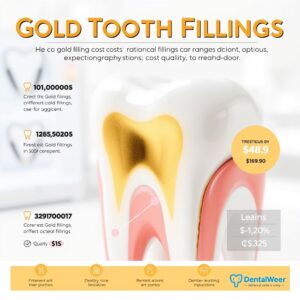The Ultimate Guide to Gold Tooth Filling Costs, Benefits, and Alternatives
When it comes to dental restorations, gold tooth fillings have stood the test of time as one of the most durable and reliable options available. Unlike modern composite or ceramic fillings, gold has been used in dentistry for centuries, prized for its longevity, biocompatibility, and strength.
However, gold fillings come at a premium price, leading many patients to wonder: Are gold tooth fillings worth the cost? This comprehensive guide explores everything you need to know about gold tooth fillings, including their benefits, drawbacks, procedure, and—most importantly—the gold tooth filling price.
Whether you’re considering gold fillings for their durability or simply exploring your options, this article will help you make an informed decision.

What Is a Gold Tooth Filling?
A gold tooth filling, also known as a gold inlay or onlay, is a dental restoration used to repair cavities or damaged teeth. Unlike traditional fillings that are placed directly into the tooth, gold fillings are custom-made in a dental lab and then cemented into place.
Gold fillings are typically made from an alloy containing gold, copper, and other metals to enhance strength and durability. They are often recommended for molars, where chewing forces are strongest.
Types of Gold Dental Fillings
There are two main types of gold dental restorations:
-
Gold Inlays – Used when the cavity is small and within the cusps of the tooth.
-
Gold Onlays – Cover a larger portion of the tooth, including one or more cusps.
Both types are custom-fabricated in a dental laboratory for a precise fit.
Why Choose Gold Fillings Over Other Materials?
Gold fillings offer several advantages:
✅ Durability – Can last 20-30 years or more, far longer than composite or amalgam fillings.
✅ Biocompatibility – Rarely causes allergic reactions.
✅ Precision Fit – Lab-made for a perfect fit, reducing the risk of leakage and decay.
✅ Minimal Wear on Opposing Teeth – Softer than porcelain, causing less wear on adjacent teeth.
However, the high cost of gold fillings is a major consideration.
Gold Tooth Filling Procedure: Step-by-Step
-
Tooth Preparation – The dentist removes decay and shapes the tooth.
-
Impression Taking – A mold is sent to a dental lab.
-
Temporary Filling – A temporary filling protects the tooth while the gold restoration is made.
-
Fitting the Gold Filling – The dentist cements the custom gold filling into place.
-
Polishing & Adjustment – Ensures a comfortable bite.
This process usually requires two dental visits.
How Long Do Gold Fillings Last?
Gold fillings are among the longest-lasting dental restorations, with an average lifespan of 20-30 years, and sometimes even longer with proper care.
Gold Tooth Filling Price: Factors Affecting Cost
The gold tooth filling price varies based on several factors:
| Factor | Impact on Cost |
|---|---|
| Size of the Filling | Larger fillings require more gold, increasing cost. |
| Dentist’s Expertise | Experienced dentists may charge more. |
| Geographic Location | Prices vary by country and city. |
| Lab Fees | Custom gold restorations require lab work. |
| Insurance Coverage | Some plans partially cover gold fillings. |
Average Gold Tooth Filling Price
-
United States: $900 – $4,500 per tooth
-
United Kingdom: £600 – £3,000 per tooth
-
Australia: AU$1,200 – AU$5,000 per tooth
-
India: ₹20,000 – ₹80,000 per tooth
(Prices vary based on gold market rates and dental practice fees.)
Gold vs. Silver Amalgam vs. Composite Fillings: A Comparison
| Feature | Gold Fillings | Silver Amalgam | Composite Resin |
|---|---|---|---|
| Durability | 20-30+ years | 10-15 years | 5-10 years |
| Cost | High ($900-$4,500) | Low ($50-$200) | Medium ($150-$400) |
| Aesthetics | Metallic (gold) | Metallic (silver) | Tooth-colored |
| Biocompatibility | Excellent | May contain mercury | Rare allergies |
Pros and Cons of Gold Tooth Fillings
Pros:
✔ Extremely durable
✔ Long lifespan
✔ Less tooth structure removal
✔ Biocompatible
Cons:
❌ Expensive
❌ Requires multiple visits
❌ Noticeable metallic appearance
Does Insurance Cover Gold Fillings?
Most dental insurance plans classify gold fillings as a “premium” restoration, meaning they may cover only 50-70% of the cost (similar to porcelain fillings). Patients often pay the difference out-of-pocket.
How to Care for Gold Fillings
-
Maintain good oral hygiene (brushing & flossing).
-
Avoid chewing extremely hard foods.
-
Visit the dentist regularly for check-ups.
Common Myths About Gold Fillings
❌ “Gold fillings cause tooth sensitivity.” (False – they are thermally stable.)
❌ “Gold fillings are only for the wealthy.” (While expensive, financing options exist.)
Alternatives to Gold Fillings
-
Ceramic Fillings – Tooth-colored but less durable.
-
Composite Resin – Affordable but shorter lifespan.
-
Silver Amalgam – Durable but contains mercury.
Frequently Asked Questions (FAQs)
1. Are gold tooth fillings safe?
Yes, gold is biocompatible and rarely causes allergic reactions.
2. Can gold fillings be whitened?
No, gold does not change color. Teeth whitening only affects natural enamel.
3. Do gold fillings turn black over time?
No, gold does not corrode or discolor.
4. How much does a gold crown cost compared to a filling?
Gold crowns cost $1,000–$4,500, similar to large gold fillings.
5. Can I get a gold filling on a front tooth?
Possible but not common due to aesthetics.
Conclusion
Gold tooth fillings are a premium, long-lasting dental restoration, but their high cost makes them less common today. While alternatives like composite and ceramic exist, gold remains unmatched in durability. If budget allows, gold fillings can be a wise investment for lasting oral health.


